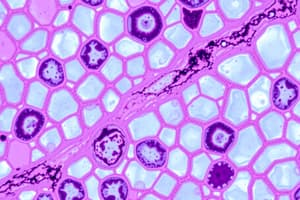Podcast
Questions and Answers
What primarily defines the extracellular matrix of tissues?
What primarily defines the extracellular matrix of tissues?
- Cells tightly packed with minimal space between them
- A collection of organelles and cell nuclei
- Only collagen and elastin fibers
- Proteins, salts, water, and other macromolecules (correct)
What characteristic is unique to epithelial tissues?
What characteristic is unique to epithelial tissues?
- Extensive extracellular matrix
- High density of cells and minimal extracellular matrix (correct)
- Cells arranged in irregular shapes
- Presence of blood vessels
Which feature is NOT associated with epithelial tissue?
Which feature is NOT associated with epithelial tissue?
- Attachment to underlying connective tissue
- Avascularity, meaning a lack of blood vessels
- Microvilli or cilia on some surfaces
- Cells arranged in multiple layers only (correct)
How does the matrix type differ between epithelial and connective tissues?
How does the matrix type differ between epithelial and connective tissues?
Which statement best characterizes muscle tissue?
Which statement best characterizes muscle tissue?
Flashcards are hidden until you start studying
Study Notes
Understanding Tissues
- A tissue is a group of cells united by a common function within the body.
- Tissues are essential for forming organs.
Tissue Composition and Characteristics
- Tissues are differentiated by:
- Cellular composition
- Extracellular matrix (ECM) components
- Functional roles
- The extracellular matrix consists of proteins, salts, water, and macromolecules.
General Functions of Epithelia
- Provides physical protection against water, chemicals, and physical injury.
- Exhibits selective permeability to control substance exchange.
- Engages in secretion (e.g., sweat, saliva) and absorption processes.
- Functions in sensation.
Characteristics of Epithelia
- High cell density with minimal extracellular matrix presence.
- Polarity: cells have distinct apical (free surface) and basal (attached) sides.
- Attachment to connective tissue on one side.
- Avascular: lacks direct blood supply.
Characteristics of Different Tissue Types
Epithelial Tissue
- Contains minimal extracellular matrix, primarily a basal lamina.
- Lacks direct blood supply.
- Surface features may include microvilli and cilia.
- Locations: Covers body surfaces, lines cavities, hollow organs, and forms secretory glands.
- Cell arrangement varies from single to multiple layers; shapes can be flattened, cuboidal, or columnar.
Connective Tissue
- Features an extensive extracellular matrix with varied types (liquid, gelatinous, firm, calcified).
- Cartilage is unique for its lack of blood supply.
- Cells are not arranged in layers and are usually dispersed in the matrix.
- Locations include supporting structures of the skin, cartilage, bones, and blood.
- Cell shapes can be irregular to round.
Muscle Tissue
- Specific characteristics of muscle tissue were not detailed in the provided text.
Studying That Suits You
Use AI to generate personalized quizzes and flashcards to suit your learning preferences.




